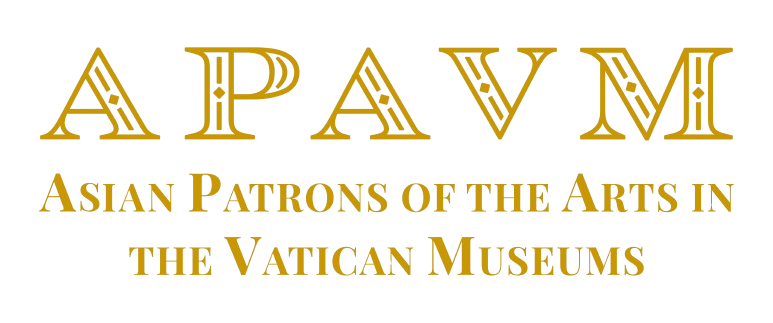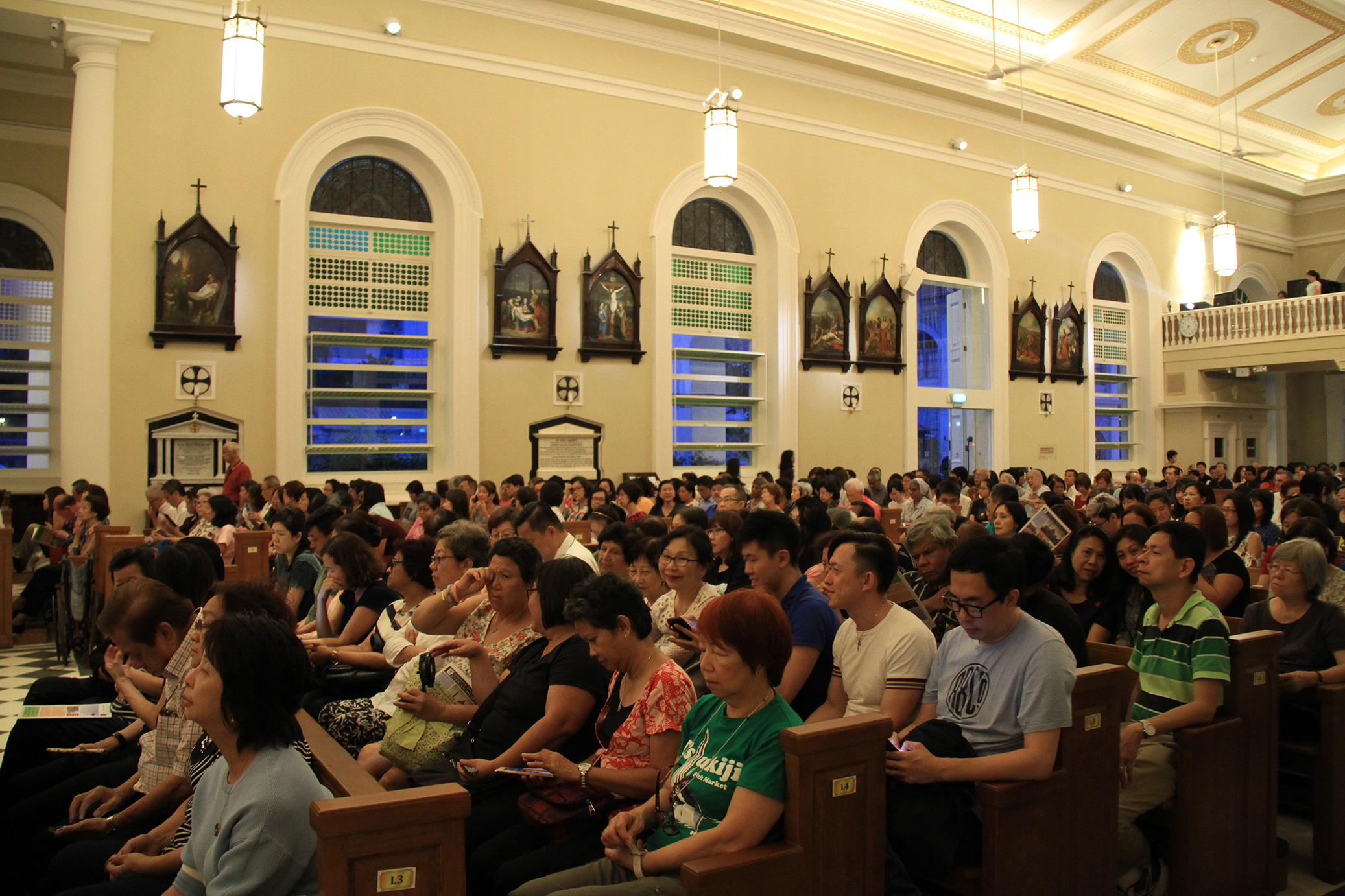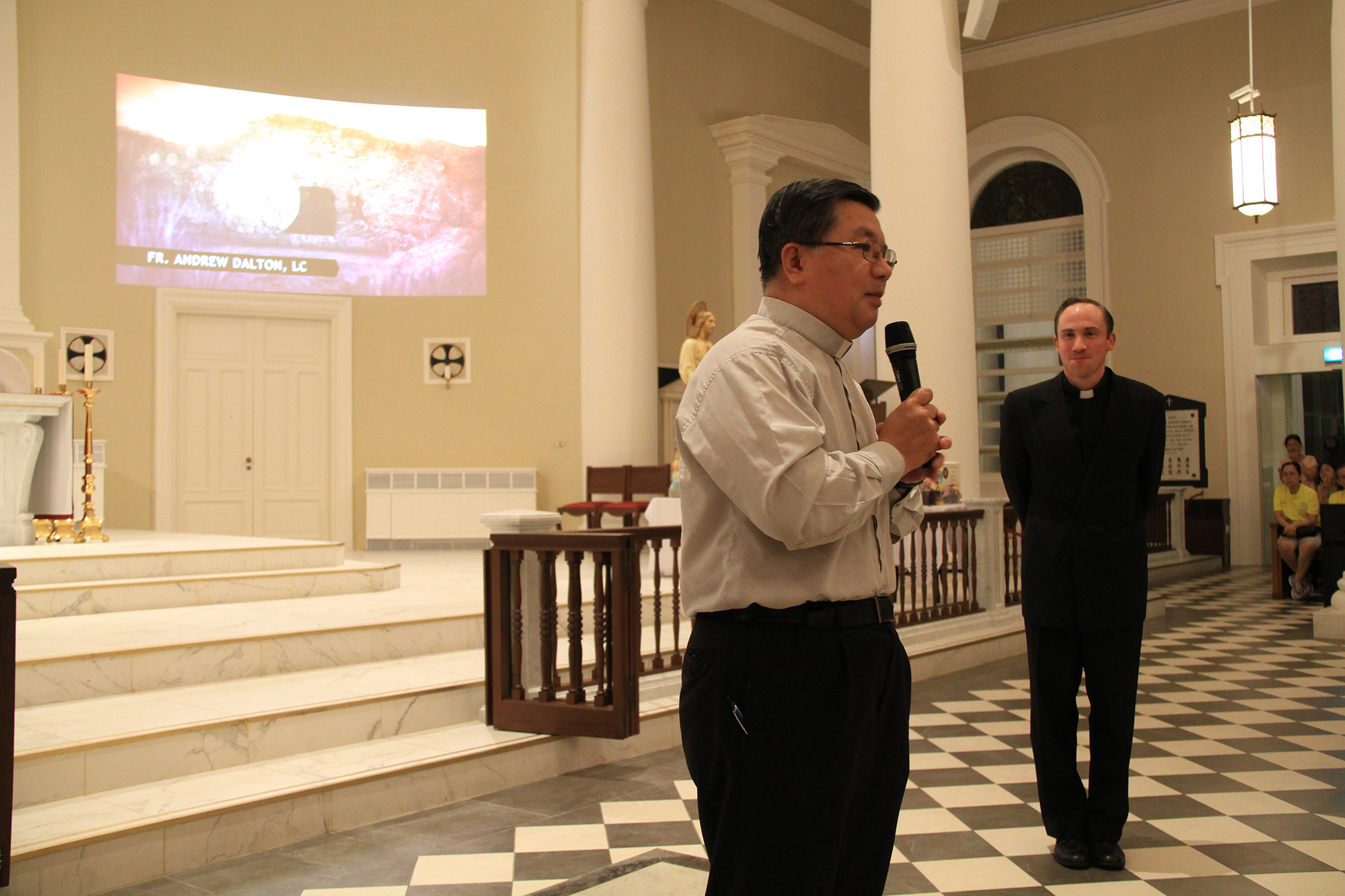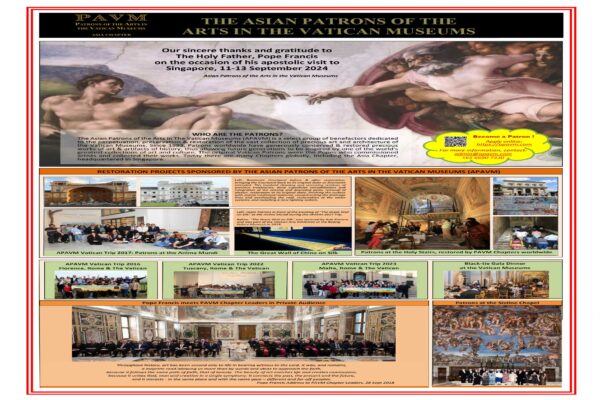Father Andrew Dalton, Holy Shroud Expert
Visit to Singapore and Hong Kong
20-28 June 2017
Father Andrew Dalton LC, an expert on the Holy Shroud of Turin, visited Singapore and Hong Kong in June 2017 and attracted full houses with his presentation “The Shroud of Turin In the Light of Science and Scripture”.
In Singapore, Father Dalton spoke at:
- Church on St Ignatius: 20 June
- YPO (an organisation for CEOs): 21 June
- Cathedral of the Good Shepherd: 22 June
- One◦15 Marina Club: 23 June (for members and guests of SPAVM)
In Hong Kong, he gave his talk at Yat Tung Heen Restaurant, Hong Kong on 28 June.
The mysterious Holy Shroud of Turin
The Holy Shroud of Turin is believed by the faithful to be the burial cloth of Jesus Christ. The image of the man on this ancient cloth is believed to be Christ himself.
Father Dalton began his talk on the Holy Shroud by pointing out that in the Gospel of John 20:4-8, the folded burial cloths of Jesus are mentioned not once but three times. Many details of his Passion are left out of the Gospels, but this seemingly unimportant fact was mentioned not once but three times. John’s Gospel also states that when the beloved disciple spied the burial cloths, “he saw and believed” (John 20:8). What did the disciple see so that he believed? Was it the burial cloth with an image of a man? Is the Holy Shroud the “silent witness” of Christ’s resurrection as it was found in the empty tomb? This is a mystery, and Father unravelled a part of it during his talks by approaching the Shroud with both the eyes of a scientist and the eyes of a pilgrim, contemplating the Shroud with both faith and reason.
In all his presentations, Father explained the empirical observations of science on the Shroud, and taught the theological and spiritual significance of the mysterious image that God has revealed in Scripture.
Scientific studies of the Holy Shroud
Father pointed out that in this day and age, we are fortunate to have science decode and amplify the Shroud’s testimony.
At the turn of the 20th century, photographic qualities were accidently discovered on the Shroud of Turin. The image was like a “negative” of a photograph. Scientists have since been intrigued by the Shroud. In the 1970s, American scientists using a special VP-8 Image Analyzer revealed that there is three-dimensional information encoded on the shroud. These findings make it highly unlikely for the Shroud to be a medieval painting. The painter would have had to be a genius to achieve the 3-D quality while making an anatomically accurate and detailed painting.
Other branches of science have also made discoveries about the shroud, an example being the botanical and geological evidence pointing to the cloth being from Jerusalem.
Father also spoke of the controversy surrounding the dating of the Shroud. In 1988, three slivers of the Shroud were tested in three labs. Each lab dated their sample to a different time in the middle ages. Father pointed out that the samples were taken from an area that was rewoven and not representative of the whole shroud.
Formation of the image
Father said another big mystery of the Shroud is the formation of the enigmatic image. Is this image the clever craftsmanship of an artist or did the body of Jesus of Nazareth imprint an image on this cloth when enveloped within? This question brought an elite crew of scientists to Italy to investigate the origins of the image but they returned home with more questions than answers. To this day, no one has been able to explain how this image came into existence, much less reproduce it in the laboratory.
The image on the Shroud is extremely superficial being only 200 to 500nm deep, (1/20 the width of a human hair). No brush strokes and directionality are found on the image. Tests done do not reveal paint, pigment, dye or varnish. One theory that emerged is that a strong light may have created it, but scientists have been unable to replicate this in the lab. Another theory is that the image may have been created by atomic radiation, but if that were so, then Jerusalem would have been flattened like Hiroshima.
The Shroud’s meaning for pilgrims
For faithful pilgrims contemplating the Shroud, there is a search for meaning in the suffering of the man whose image is imprinted on the linen: the marks on the Shroud show that he was beaten and scourged, crowned with thorns, pierced in the side, and killed on a cross. Father Dalton taught that while science can tell us how the man of the Shroud suffered, it cannot tell us the reason why. For that he said, the faithful need a broad and lofty vision, which is the Word of God. The Word of God shines a supernatural light on the Shroud and gives it meaning. The Word of God complements and elevates the findings of natural reason. Father quoted Saint John Paul II who once wrote, “Faith and reason are like two wings on which the human spirit rises to the contemplation of truth” (Fides et Ratio, 1).
The Fifth Gospel
According to Father Dalton, the Shroud has been called the fifth Gospel because the image reflects the Passion of Jesus as described in the Gospels. St John Paul once said, “There is no holiness without devotion to the Passion”, and the Shroud reveals the excruciating details of the Passion for the pilgrim to contemplate.
One of these details is that the wrists of the man on the Shroud were pierced and not his hands, as popularly depicted in works of art. Consequently, the median nerves which run through the middle of the wrists would have been pierced. Whilst hanging on the cross, Jesus would have had to lift up his body in order to breathe, and he would have done so by pressing down on his nailed feet. This movement would have caused his wrists to pivot around the nails, sending shooting pains through His arms because the nails are piercing the median nerves. Through this unbearably painful breathing, Jesus said “Father, forgive them for they know not what they do”. This proclamation of Christ, Father Dalton explained, shows His radical love for mankind and gives meaning to all the pain that He suffered.
Response
Father Dalton’s insightful talks were given in churches and secular venues, and delivered to audiences that had both Catholics and non-Catholics. Many who heard Father Dalton speak said that they were moved by the information he shared and captivated by his fluent and engaging delivery.
About Father Andrew Dalton, LC
Father Andrew Dalton is a Catholic priest of the Legionaries of Christ, who found his vocation while studying at the Georgia Institute of Technology. After earning a bachelor’s degree in philosophy and theology from the Pontifical Athenaeum Regina Apostolorum, he specialized in Biblical languages at the Pontifical Biblical Institute and Biblical Theology at the Pontifical University of the Holy Cross. As he pursues his doctorate, he is currently an adjunct professor of theology at the Pontifical Athenaeum Regina Apostolorum in Rome, where he teaches Biblical Hebrew, Biblical Greek, and the Synoptic Gospels. He also teaches the Biblical Theology of the Passion of the Christ as part of the Diploma in Shroud Studies offered by the Institute of Science and Faith in collaboration with the International Center of Sindonology in Turin and the Giulio Ricci Diocesan Center of Sindonology in Rome. Fr Dalton is also a board member for Othonia, a center for investigation and study of the Shroud with exhibitions all over the world.










